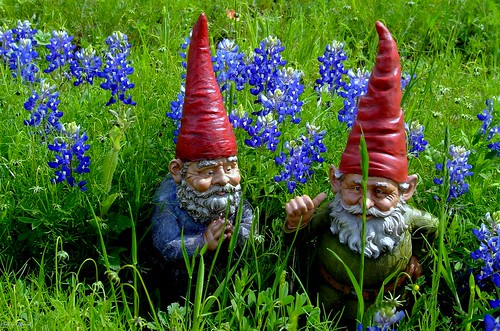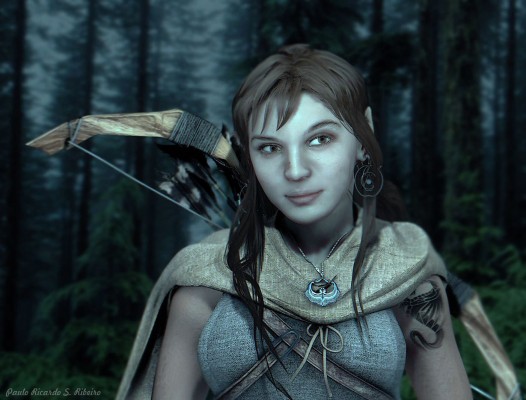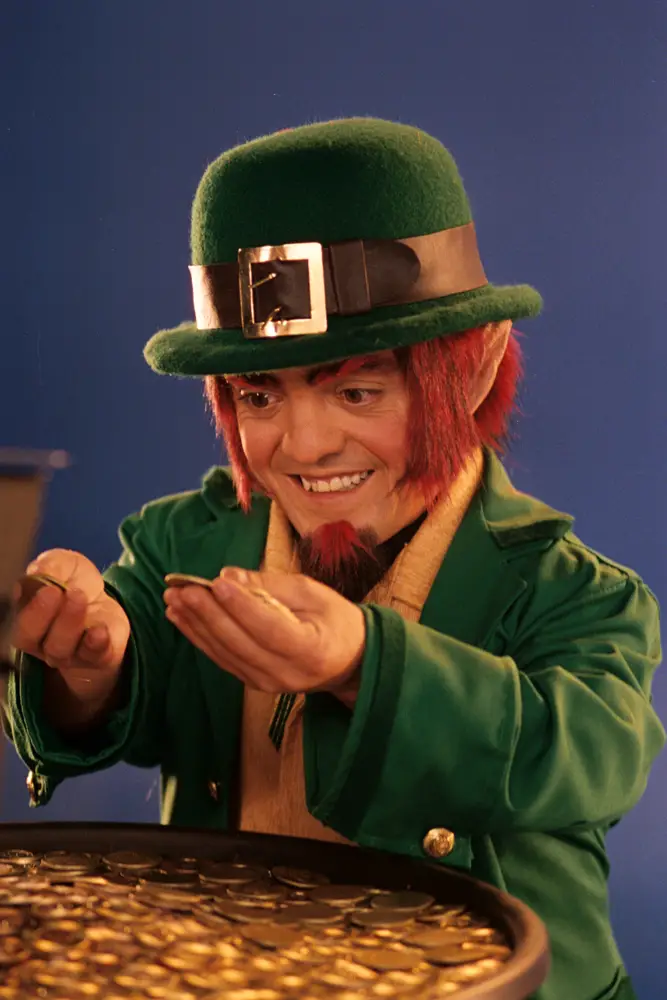 Submitted by LOGOS - Overseer on
Submitted by LOGOS - Overseer on

~GOBLINS~
A goblin is a small-size fairy creature, described as a grotesquely evil and somewhat related to the brownie and gnome. They are also known by the names: Hobgobs, Gobelins, Hob-thrush, Blobins, Bogles, Bogies, Brags, Boggarts, …
The word goblin is derived from the French gobelin, rendered as Middle Latin gobelinus, itself a loan from a Germanic term cognate to German kobold. Another root is the Greek kobalos meaning rogue. The term goblin can apply either to the ugliest members of the fae, or to certain sub-races. Those fae numbered among the goblin sub races, include the Scottish Trows, English Spriggans, Welsh Knockers, Cornish Knockers, German Kobolds and Wichtlein, the Irish Phooka and even Shakespeare's infamous Puck.
Often portrayed as the villains and troublemakers of faerie, Goblins are not truly completely evil. Though they seem to have no moral code of their own, they are happy to enforce the one of their human hosts. The miserly and lazy are apt to feel their pinch or find their rooms and possessions in disarray. Goblins were fiercely loyal and allied with particular sorcerer or witch tribes, whom they protected and served as an equally allied tribe rather than servants or slaves. "This perception might seem a bit strange to any not accustomed to the goblin outlook" because the goblins often did what might be considered slave work for very little in return.
Goblins are pranksters, and are known for rearranging items in the house, tangling horses, banging pots and pans, removing the clothes from sleeping humans, knocking on doors and walls and even digging up the graves to scatter the bones around. Mine goblins make knocking noises by striking pickaxes and hammers against the stones. Some miners take the resulting sounds as a sign of good luck, believing they indicate the presence of rich deposits of ore. Other believe that they (Kobolds and Wichtlein) just imitate the miners to fool them. As a death companion he is sometimes accused to cause underground fires or warn for the coming deaths. To avoid the Knockers' wrath, a pastie (traditional miner meal) should be left for them.

~TROLLS~
Trolls are guardians of bridges and byways, though their help seems arbitrary and dubious. They are sometimes psycho pomp (passers-by) like Caron and the Ankou. In Scandinavia, Trolls were believed to be giants, and the biggest of them all was Dovregubben (their king in the mountain Dovre). They were shaggy and rough-haired, with trees and moss-like growth on their heads and noses. Their noses were long and they would stir with it when cooking broth or porridge. Some even had two or three heads, some only had one eye in the middle of their foreheads. Their features differed from humans with four fingers and four toes and a tail resembling that of a cow. The trolls lived hundreds of years but the sunlight turns them into stone.
Trolls usually live in mountains, forests and near lakes. In children's stories, trolls often live beneath bridges, harassing passersby and exacting tolls. When travelling, they tend to run in packs.
Their supernatural powers consisted of :
- Shape-shifting, for instance into rain and storms, fierce animals or beautiful young ladies.
- Forecasting the future
- Superhuman force
Other faeries and wild animals tend to avoid them if possible. They are carnivorous as well as nocturnal, but are not known for eating human flesh (the Ogre does). They rarely steal human mates or human babies, whom they regard as worthless and smelly. Goat and mutton are their favorite meats, and they are noted for having abysmal table manners. In some less frequent stories, the troll is similar to the Ogre and would devour humans and babies, its favorite phrase being “hum, hum, it smell Christian’s blood …”

~GNOMES~
Gnomes are very widespread species, known to a number of human races. Germans name them Erdmanleins, except in the Alpine areas, where they are called Heinzemannchens. In Denmark and Norway they are Nisse; Nissen is a Swedish variation. In Brittany they are called Nains. Tontti to the Finns and Foddenskkmaend is their name in Iceland. The Polish call they by the familar Gnom. Bulgaria and Albania, however, use Dudje. In Hungary, Yugoslavia, and Czechoslovakia, Gnomes are called Mano. The Dutch use Kabouter and the Belgian, Skritek. Switzerland and Luxembourg use the same name, Kleinmanneken, which means "littlemen." Domovoi Djedoes is used in western Russia. Originating in Scandinavia, Gnomes later migrated to the lowlands some 1500 years ago.
Gnomes consist of a number of different types. The most common is the Forest Gnome who rarely comes into contact with man. The Garden Gnome lives in old gardens and enjoys telling melancholy tales. Dune Gnomes are slightly larger than their woodland brethren and choose remarkably drab clothing. House Gnomes have the most knowledge of man, often speaking his language. It is from this family that Gnome Kings are chosen. Farm Gnomes resemble their House brethren, but are more conservative in manner and dress. Siberian Gnomes have been more interbred than other Gnomes and associate freely with trolls. They are much larger than the other types and have an infinitely more nasty nature. It is best never to evoke the ire of such Gnomes for they delight in revenge.
Gnomes are usually an average of 15 centimeters tall, but with its cap on it appears much taller. Their feet are somewhat pigeon toed which gives them an extra edge on speed and agility through the wood and grass. The males weigh 300 grams, and female is 250-275 grams. The male wears a peaked red cap, a blue brown-green pants, and ether felt boots, birch shoes, or wooden clogs. Around his waist is a belt with a tool kit attached, holding a knife, hammer, etc. They are fair of face, though the boast rosy red cheeks. Long beards adorn their faces and turn gray far sooner than their hair.
The female wears gray or khaki clothing, consisting of a blouse and skirt (to ankles). She also has black-gray knee socks and high shoes or slippers. Before she is married, she dons a green cap.
Prior to marriage her hair in hanging down, the outfit is complemented by a green cap and braids with which later disappear under a scarf while the green cap is replaced by more somber tones after she marries.
Males are the guardians of animal kind and show little preference for their animal friends, not withstanding their aversion to cats both wild and domesticated. They are known for freeing wildlife from man's traps and for operating on farm animals whose owners have neglected them or who are simply too poor to afford a veterinarian. Their enemies are mainly Trolls, and other beings who would try to destroy them or their homes. Otherwise, they are mostly peaceful beings.
Most Gnomes are 7 times stronger than a man, can run at speeds of 35 miles per hour, and have better sight than a hawk. These abilities help the Gnome to do many things, such as find wounded, dying animals for which they feel they are responsible for. Because of their love for animals, all the animals of the forest are the Gnome's friends and are willing to help him at any time. Many people say that gnomes have elevated practical jokes to an art form. But most especially they love gems and jewelry and are considered by many to be the best gem cutters and jewelers in existence
They are generally vegetarian and never worry. The main meal consists of: Nuts (hazelnuts, walnuts, beechnuts, etc), mushrooms, peas, beans, a small potato, applesauce, fruit, berries (all kinds), tubers, spices, vegetables, and preserves for dessert. As a beverage, the gnome drinks mead dew (fermented honey), fermented raspberries (which have a very high alcohol content), and spiced gin as a nightcap. The gnome eats no meat, so often consumes the nectar of the high protein plant called 'Vicia Sepuim', fluffy willow catkins, dressing them up like dolls.

~ELVES~
Elves, originally found in Germanic and Scandinavian folklore, were a very mysterious race from the beginning of time. Later they became supernatural beings, mainly shaped as humans. They were worshipped in trees, mountains and waterfalls.
Elves is often used as a general term for fairies especially in the Nineteenth anglo-saxon litterature. The king of the elves, Oberon, and his wife Titania appear in some very important works of medieval literature, such as Huon de Bordeaux and Shakespeare's A Midsummer Night's Dream. You may also be interested in how Tolkien rendered the elfic concept in his own mythical saga.
In early modern and modern folklore, they become associated with the fairies of Romance folklore and assume a diminutive size, often living mainly in forests but also underground in hills or rocks, or in wells and springs. 19th-century Romanticism attempted to restore them to full stature, often depicting them as very young, probably adolescent (lack of facial hair on male elves), men and women of great beauty.
According to the Norse Edda, te white spirits, or Elves of Light, were exceedingly fair, more brilliant than the sun, and clad in garments of a delicate and transparent texture. They loved the light, were kindly disposed to mankind, and generally appeared as fair and lovely children. Their country was called Alfheim, and was the domain of Freyr, the god of the sun, in whose light they were always sporting.
Elves vary in size from 4'10" and 5'8". However, according to their delicate bodies they seem much taller than they really are. Often male and female elves are hard to discern, at first glance. Both sexes usually have big, expressive eyes (in the most splendid colors). They wear their hair uncut and open, have graceful, fragile features and are of extraordinary beauty. Male elves also don't have any beard growth. Very typical for elves are their pointed ears, and high cheekbones. In modern descriptions, elves are either light or dark, the light elves having starlike eyes, faces brighter than the sun, and golden-colored hair; the dark elves are pitch black and have sometimes fluorescent eyes, this quality being indicative of their dealing with black magic. Both are attractive, in appearance at least. Elves prefer greens and greenish-greys while dark elves prefer blacks, dark grey, and sometimes silver.
Dark or light, the elven race is rarely seen and if so, elves only appear on certain times and on special places in the untouched nature. During the course of time elves moved to other places in the world and in many tribes their spiritual shape was lost completely and elves changed to beings consisting of blood and flesh. The light elves are a peaceful, nature-loving who love beautiful things and often try themselves in the arts of drawing and music. The black or dark elves are also called "Drow". Beautiful, agile, proud, dexterous and extremely deadly, they are the Drow, Elves of the underground. Very few is know about them.
In comparison to humans, elves are stronger in spirit and in limb and have an exceptional constitution and endurance. When they grow older they seldom get weaker, instead they become wiser and even fairer. Elven senses, especially of hearing and sight, are much keener and intense than those of Men and are highly resistant to extremes of temperatures and also have several natural defenses against magical influences. The long life-spans of elves may be accounted to one of the main reasons that elves are very calm and patient in all their actions.
Even if some elves are said to be immortal, elves of all other tribes die a natural death after long lives. The amount of years elves live indeed varies enormously, ranging from 100 years to over 1000. It is also known that very often elves end their lives of their own will when they see a necessity to do so or if they think that their life's goal has been reached. Of course elves may also die when they are wounded severely, but in general elves heal very fast when they are tended to quickly. Death on the other hand is nothing an elf fears. The fact of death is interpreted by the elves as a return to nature.
The black or Night Elves were a different kind of creatures. Ugly, long-nosed dwarfs, of a dirty brown color, they appeared only at night, for they avoided the sun as their most deadly enemy, because whenever his beams fell upon any of them they changed them immediately into stones. Their language was the echo of solitudes, and their dwelling-places subterranean caves and clefts.
They were supposed to have come into existence as maggots produced by the decaying flesh of Ymir's body, and were afterwards endowed by the gods with a human form and great understanding. They were particularly distinguished for knowledge of the mysterious powers of nature, and for the runes which they carved and explained.
They were the most skilful artificers of all created beings, and worked in metals and in wood. Among their most noted works were Thor's hammer, and the ship "Skidbladnir," which they gave to Freyr, and which was so large that it could contain all the deities with their war and household implements, but so skillfully was it wrought that when folded together it could be put into a side pocket.

~LEPRECHAUNS~
The Leprechaun is a diminutive male solitary Irish faery who loves to play pranks on humans. Variant names include lurachmain, lurican, lurgadhan. The name leprechaun may have derived from the Irish leath bhrogan (shoemaker), although its origins may lie in luacharma'n (Irish for pygmy). Leprechauns can be found in wild areas with large grassy hills.
The leprechaun 'family' appears split into two distinct groups - leprechaun and cluricaun. Cluricauns may steal or borrow almost anything, creating mayhem in houses during the hours of darkness, raiding wine cellars and larders. They will also harness sheep, goats, dogs and even domestic fowl and ride them throughout the country at night.
Leprechauns are shoemakers by trade however they only work on one shoe and only serve other fae. They do not enjoy working with fellow faeries and keeps to himself except for at parties. They have been known to invite humans do these, which can be joined as long as they do not fear them, drink, or dance with them.
Leprechauns have one wickedness, they are frequently to be found in an intoxicated state, caused by home-brew poteen. However they never become so drunk that the hand which holds the hammer becomes unsteady and their shoemaker's work affected. Besides the fact they can use foul language, they also smoke awful smelling pipes and manage to drink a lot of stout, even straight from the jug.
Leprechauns have also become self-appointed guardians of ancient treasure (left by the Danes when they marauded through Ireland), burying it in crocks or pots. This may be one reason why leprechauns tend to avoid contact with humans whom they regard as foolish creatures. If caught by a mortal, the leprechaun will promise great wealth if allowed to go free. He carries two leather pouches. In one there is a silver shilling, a magical coin that returns to the purse each time it is paid out. In the other he carries a gold coin which he uses to try to bribe his way out of difficult situations. This coin usually turns to leaves or ashes once the leprechaun has parted with it. However, you must never take your eye off him, for he can vanish in an instant.
Data from http://www.monstrous.com